When I moved to the BC coast it was a big enough thrill to see whales in the distance, with a spray of air and water and a glimpse of their backs as they surfaced. I have seen several Humpbacks, Killer Whales, and a few Grey Whales while out on research trips, and had a close shave with a Humpback while sailing, but the week of April 20th takes the cake.
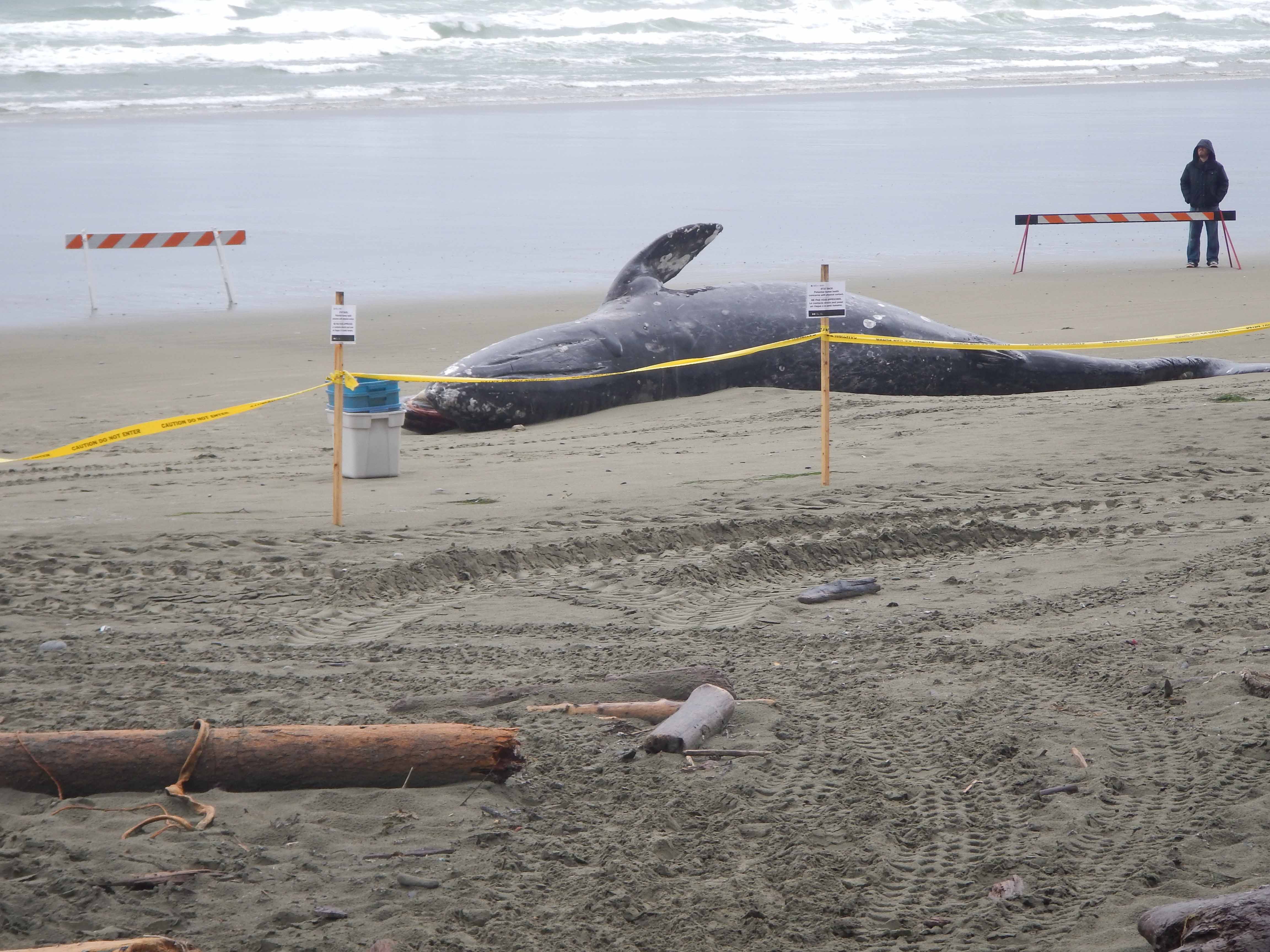 On Monday April the 20th, a 10 m yearling female Grey Whale washed up on the beach, near the Kwisitis Visitor Center. A crew was hurriedly assembled to examine the animal and remove it before the tide came in and before predators scavenged the carcass. The question was – Dump it all at sea, or save the skeleton? The decision was made to clean the skeleton and prepare it for the RBCM’s collection – so that changed things a bit. The disarticulation of the skeleton had to be done carefully – but with the same time constraints – we wanted the whale off the beach by end of Thursday April 23rd.
On Monday April the 20th, a 10 m yearling female Grey Whale washed up on the beach, near the Kwisitis Visitor Center. A crew was hurriedly assembled to examine the animal and remove it before the tide came in and before predators scavenged the carcass. The question was – Dump it all at sea, or save the skeleton? The decision was made to clean the skeleton and prepare it for the RBCM’s collection – so that changed things a bit. The disarticulation of the skeleton had to be done carefully – but with the same time constraints – we wanted the whale off the beach by end of Thursday April 23rd.
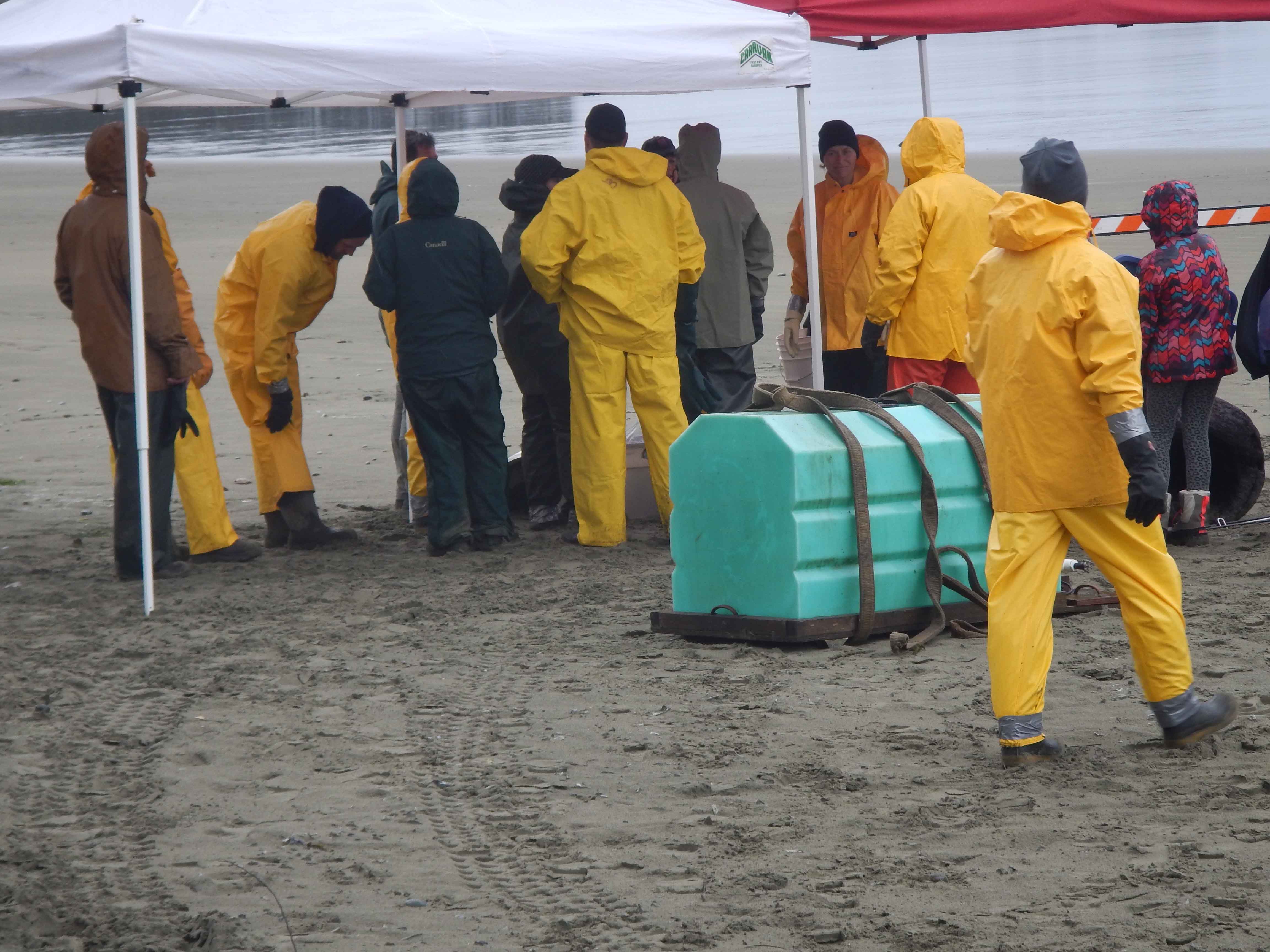 We had people from Parks Canada, Fisheries and Oceans Canada, Cetacea Contracting, Strawberry Isle Marine Research Society, the Ucluelet Aquarium, the Vancouver Aquarium, and numerous whale experts and dedicated volunteers to help dissect the whale. We assembled by 08:30, and after a short set of introductions and an orientation, we discussed safety, and then suited-up and got to work.
We had people from Parks Canada, Fisheries and Oceans Canada, Cetacea Contracting, Strawberry Isle Marine Research Society, the Ucluelet Aquarium, the Vancouver Aquarium, and numerous whale experts and dedicated volunteers to help dissect the whale. We assembled by 08:30, and after a short set of introductions and an orientation, we discussed safety, and then suited-up and got to work.
 Between 9:00AM and 6:30PM on April 23rd, we reduced the whale to its skeleton (mostly) and Lisa Spaven, of the Cetacean Research Program, Fisheries and Oceans Canada, did a necropsy to try determine the cause of death. The short answer? The whale looked pretty normal with no obvious signs of trauma.
Between 9:00AM and 6:30PM on April 23rd, we reduced the whale to its skeleton (mostly) and Lisa Spaven, of the Cetacean Research Program, Fisheries and Oceans Canada, did a necropsy to try determine the cause of death. The short answer? The whale looked pretty normal with no obvious signs of trauma.
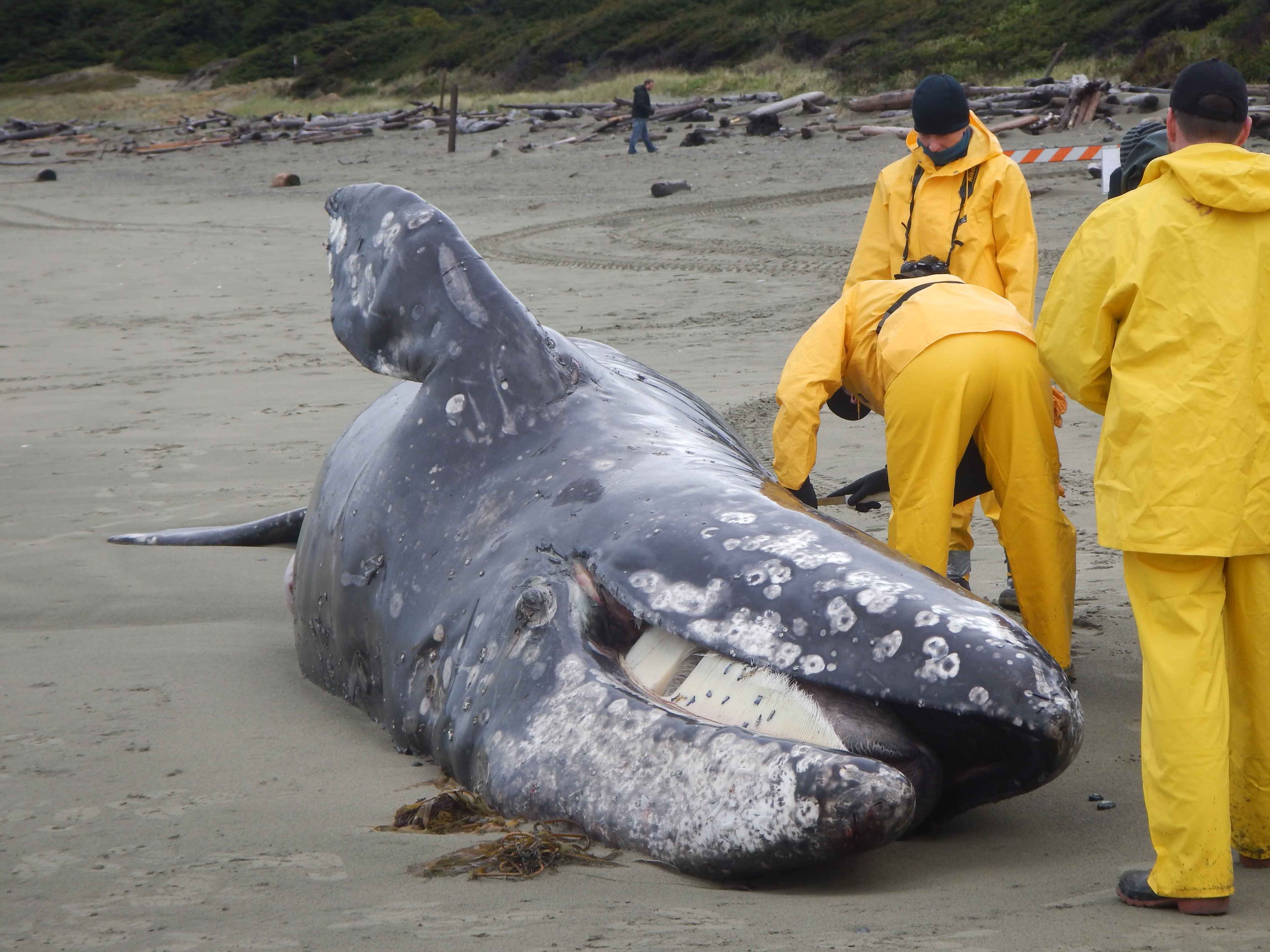 It is quite the sight to reach the top of the beach ridge, and see the whale only a few meters away. The first step – remove the blubber from the left side of the animal (that was the side facing us). This was when everyone was most nervous. No one wanted to be the first to cut too deep and cause an explosive release of gas from the animal’s body cavity. This animal had only been dead a few days, so there was no risk of it going into low-orbit, but there was a fair bit of gas which had to be released. Eventually a high pitched squeal, followed by scattering volunteers, meant that someone had cut a bit deep. Those downwind raised their arms to their noses in a vain attempt to exclude the effluvia. I was amazed how many onlookers stayed downwind (north of the whale) – it was far fresher on any other compass heading.
It is quite the sight to reach the top of the beach ridge, and see the whale only a few meters away. The first step – remove the blubber from the left side of the animal (that was the side facing us). This was when everyone was most nervous. No one wanted to be the first to cut too deep and cause an explosive release of gas from the animal’s body cavity. This animal had only been dead a few days, so there was no risk of it going into low-orbit, but there was a fair bit of gas which had to be released. Eventually a high pitched squeal, followed by scattering volunteers, meant that someone had cut a bit deep. Those downwind raised their arms to their noses in a vain attempt to exclude the effluvia. I was amazed how many onlookers stayed downwind (north of the whale) – it was far fresher on any other compass heading.
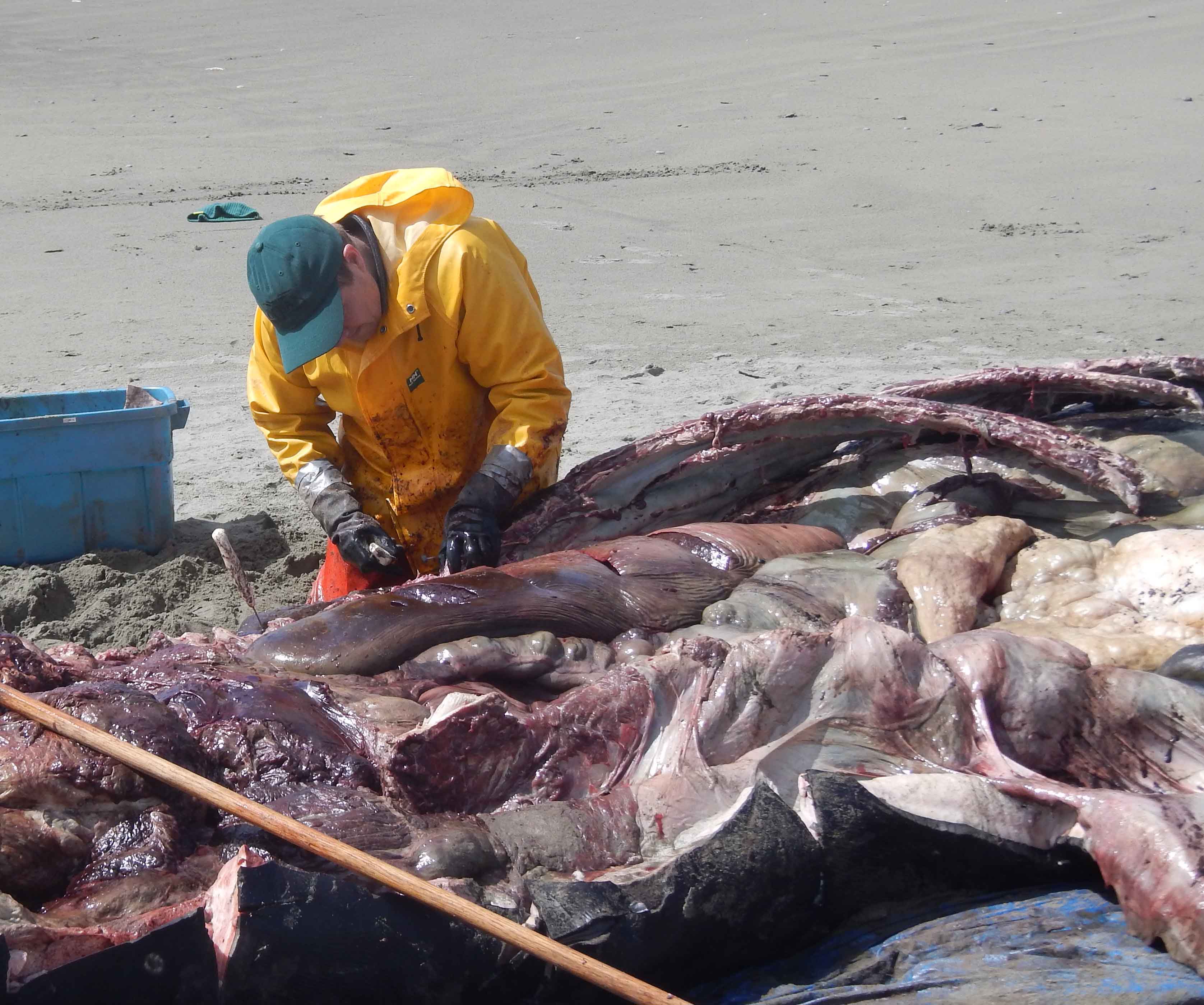 With the majority of the gas released, Lisa continued with her necropsy, which meant she examined the organs for any unusual colours, textures, or any sign of impacts, hemorrhages, etc. Tissue samples taken during the necropsy have been sent away for microscopic examination – we’ll see whether they show any other evidence for the cause of death. As Lisa said in a recent email, “The case is not closed on this animal just yet.”
With the majority of the gas released, Lisa continued with her necropsy, which meant she examined the organs for any unusual colours, textures, or any sign of impacts, hemorrhages, etc. Tissue samples taken during the necropsy have been sent away for microscopic examination – we’ll see whether they show any other evidence for the cause of death. As Lisa said in a recent email, “The case is not closed on this animal just yet.”
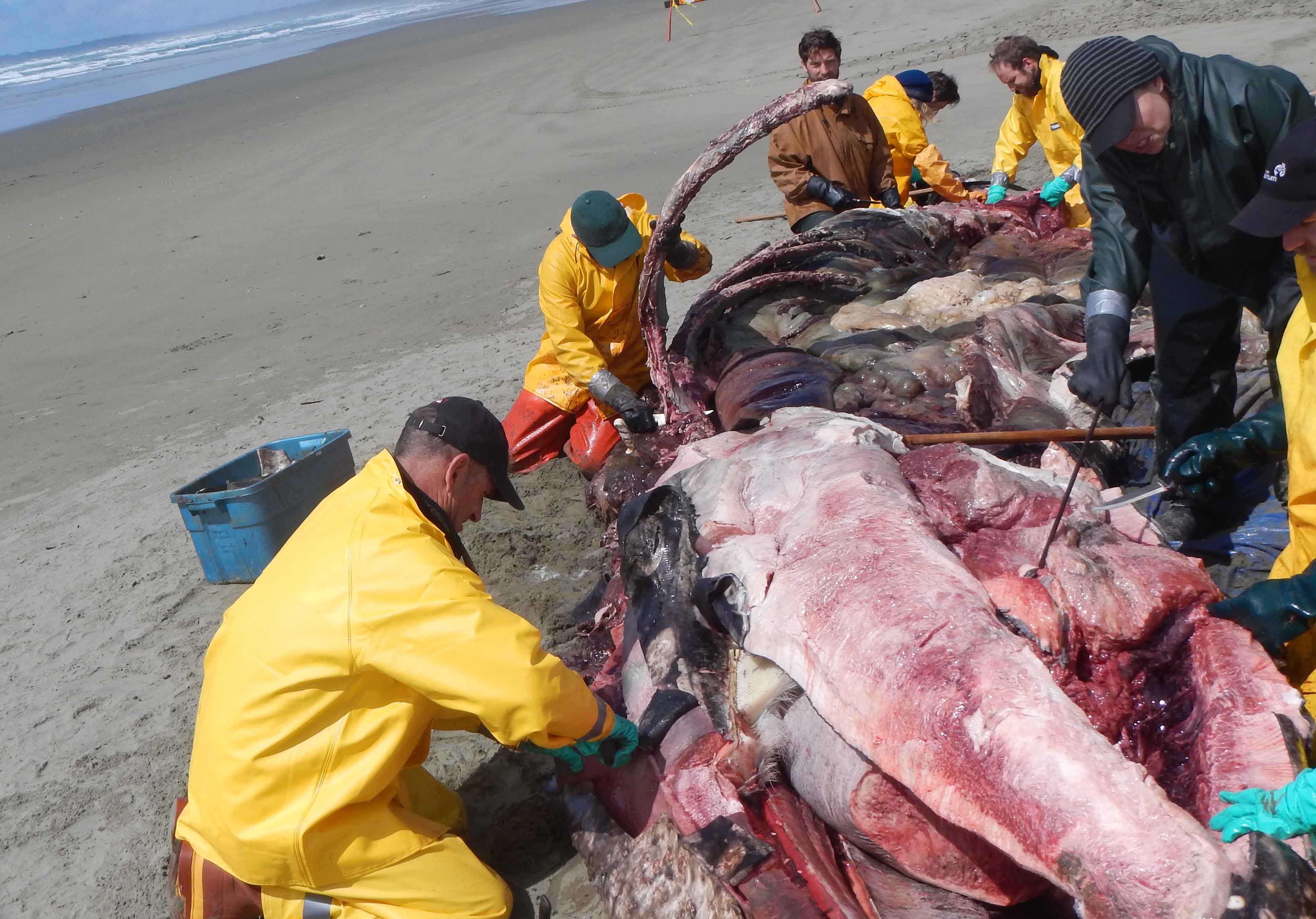 While she did her work, we set about removing as much muscle and fat as we could, and disarticulated the skeleton. I got the job of separating the left pectoral flipper at the shoulder socket. This whale is a quantum leap from the cats and mink used in undergraduate anatomy labs. Luckily, vertebrates have a fairly conservative body plan and the anatomy makes sense.
While she did her work, we set about removing as much muscle and fat as we could, and disarticulated the skeleton. I got the job of separating the left pectoral flipper at the shoulder socket. This whale is a quantum leap from the cats and mink used in undergraduate anatomy labs. Luckily, vertebrates have a fairly conservative body plan and the anatomy makes sense.
Once we got the pectoral flipper and shoulder blade off, I was tasked with the location and removal of the pelvic girdle. Funny thing was: this was my first whale dissection, and someone (laughably) thought I was “the brains” of the operation. Yes I am still laughing at that. The pelvic girdle is reduced to a splint of bone – roughly banana shaped and not far-off the size of a banana on this small whale. You have to remove all the fat from around the animal’s anus, and then press on the muscles in that region. The bones are buried, but you can feel them relative to the softer muscle tissue on the flank. I am guessing the search for pelvic bones is more difficult in larger whales. Once you find the pelvic bones, a sharp knife makes short work of their removal. Ribs also pop off easily once you get the hang of it.
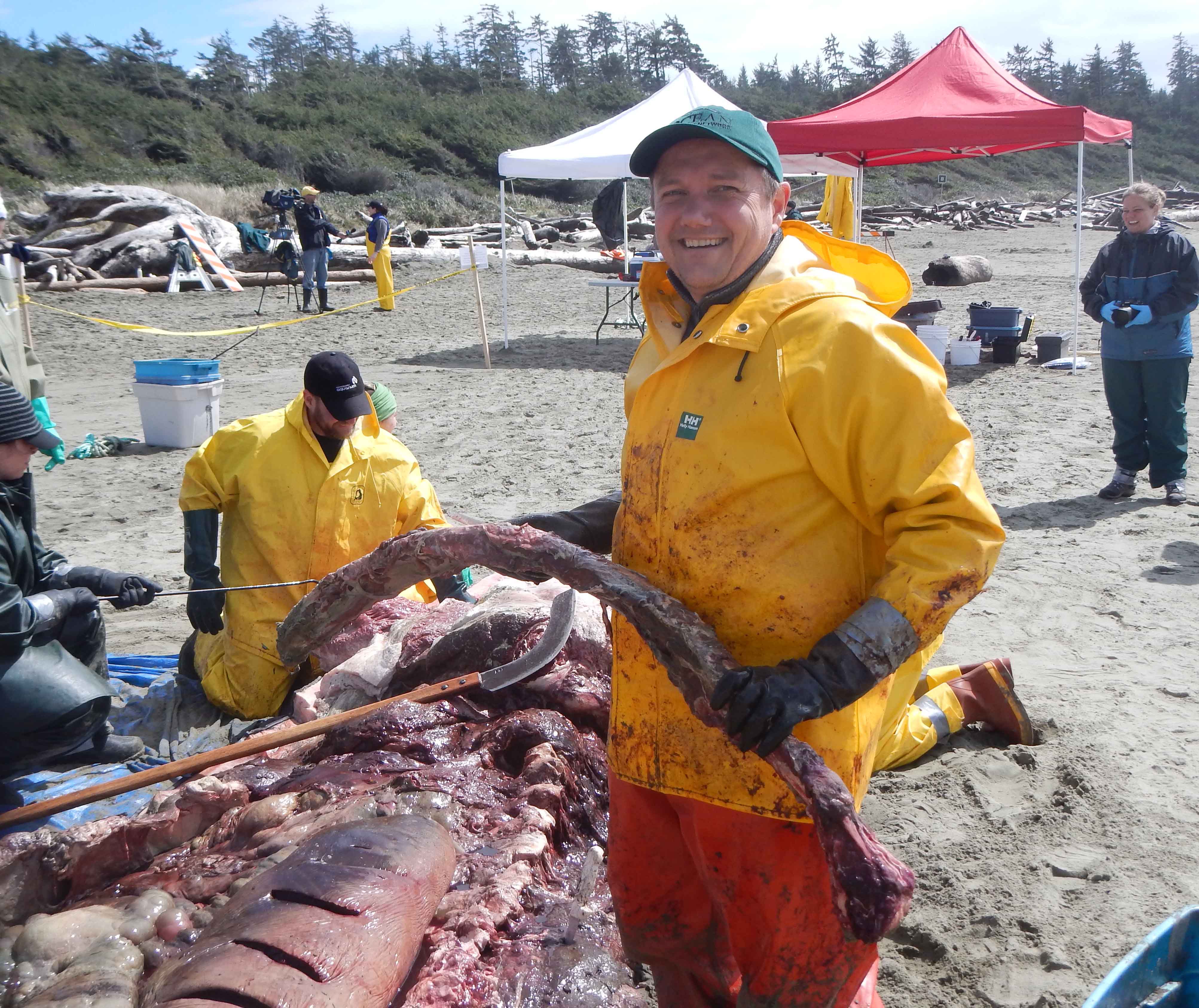 It is amazing how fast knives lost their edge, and I have to thank Ken Parkinson – my step-Dad for his skills with a whetstone. He lost count of how many knives he sharpened and re-sharpened that day. When Ken volunteered to come along that day, I wasn’t sure what we’d get him to do (he took the photos I have used in this post). But everyone was glad he found his niche in the work party.
It is amazing how fast knives lost their edge, and I have to thank Ken Parkinson – my step-Dad for his skills with a whetstone. He lost count of how many knives he sharpened and re-sharpened that day. When Ken volunteered to come along that day, I wasn’t sure what we’d get him to do (he took the photos I have used in this post). But everyone was glad he found his niche in the work party.
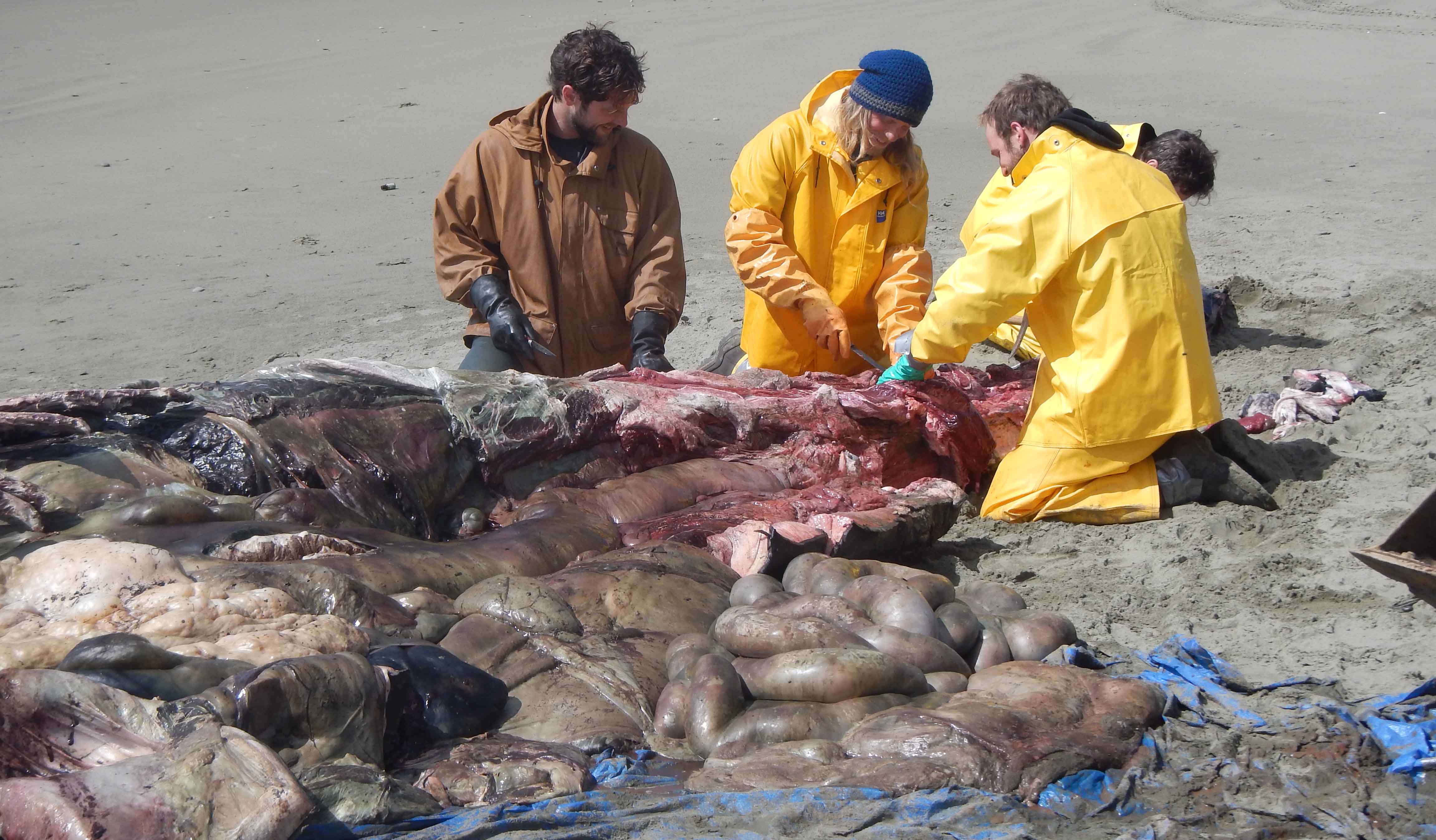 Large chunks of meat and fat were easy to drop into the tractor’s shovel for disposal, but the intestines were another matter. I think five of us wrestled with the intestines to get them into the tractor – and then we hoped that they stayed in place en-route to the dump truck. The tractor driver shared our sentiment. The discarded fat, organs and muscle were loaded into a boat and then dumped at sea and recycled nature’s way. I am sure there were happy hagfish and sharks that day – and a few days after.
Large chunks of meat and fat were easy to drop into the tractor’s shovel for disposal, but the intestines were another matter. I think five of us wrestled with the intestines to get them into the tractor – and then we hoped that they stayed in place en-route to the dump truck. The tractor driver shared our sentiment. The discarded fat, organs and muscle were loaded into a boat and then dumped at sea and recycled nature’s way. I am sure there were happy hagfish and sharks that day – and a few days after.
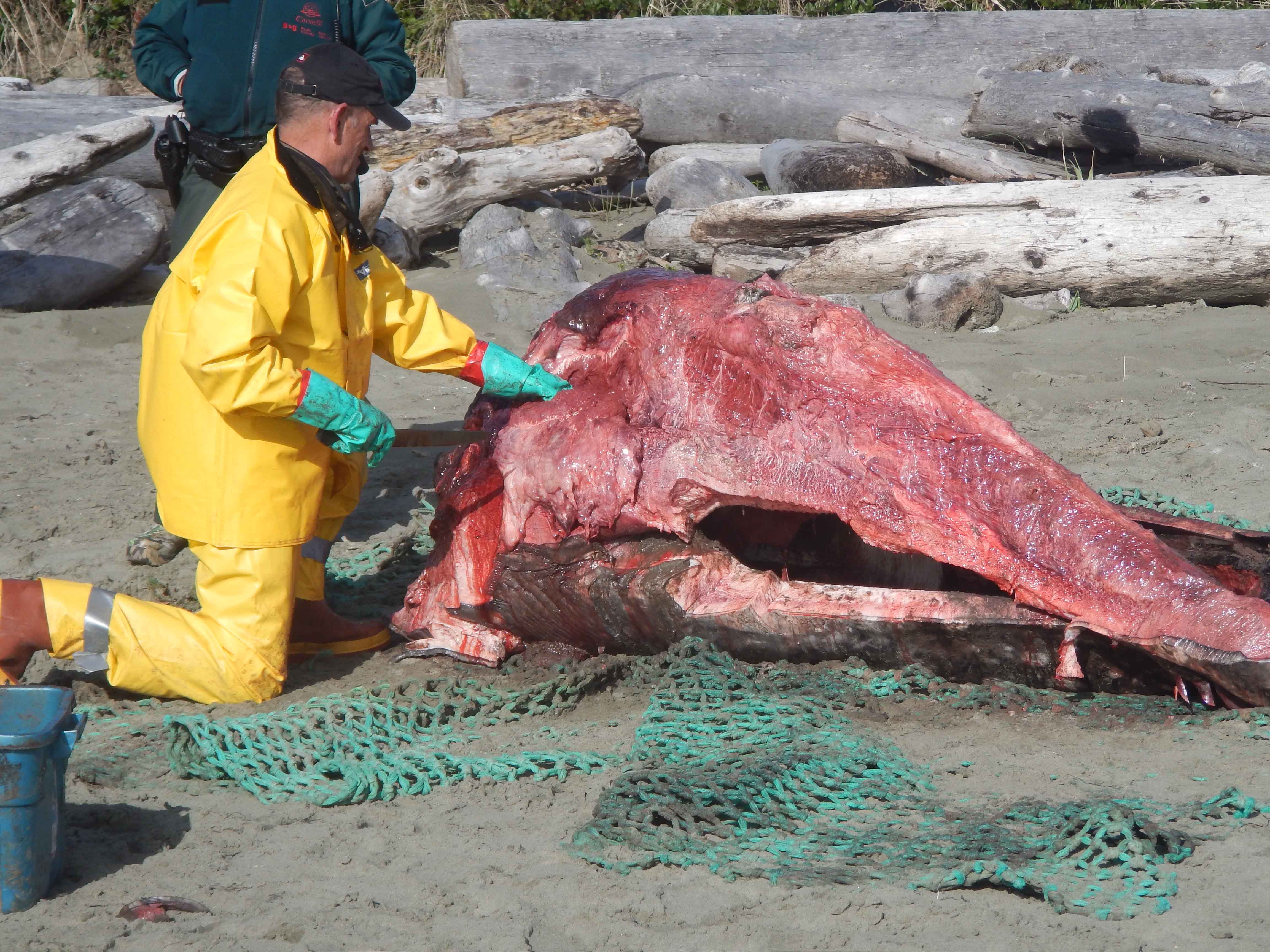 Five people worked on the head – there was a lot of material to remove – including the baleen – which we saved. To be honest, I was so busy, entire organ systems were removed and I never saw them. I never did see the tongue get removed. It was gone by the time we separated the head from the vertebrae.
Five people worked on the head – there was a lot of material to remove – including the baleen – which we saved. To be honest, I was so busy, entire organ systems were removed and I never saw them. I never did see the tongue get removed. It was gone by the time we separated the head from the vertebrae.
It was a non-stop process through waves of rain and strong wind, and long periods of warm sunshine. I am not sure which was worse. The rain and wind was uncomfortable, but we were wrapped up anyway to avoid getting any mess on our clothes. Rain wasn’t an issue – although we did ask for help from people with clean hands to lift our raincoat hoods. The sun also made things uncomfortable – we were wrapped in rain gear, boots, and gloves – all duct-taped together. In the sunshine, our best friends were the volunteers with clean hands that opened juice boxes and handed us cups of water. Thank you very much. All I ate during the dissection was one granola bar – Ken carefully unwrapped it and fed it to me. Don’t get me wrong, there was plenty of food provided by Parks Canada, but I didn’t want to stop. I can go three days without eating – so it was no problem.
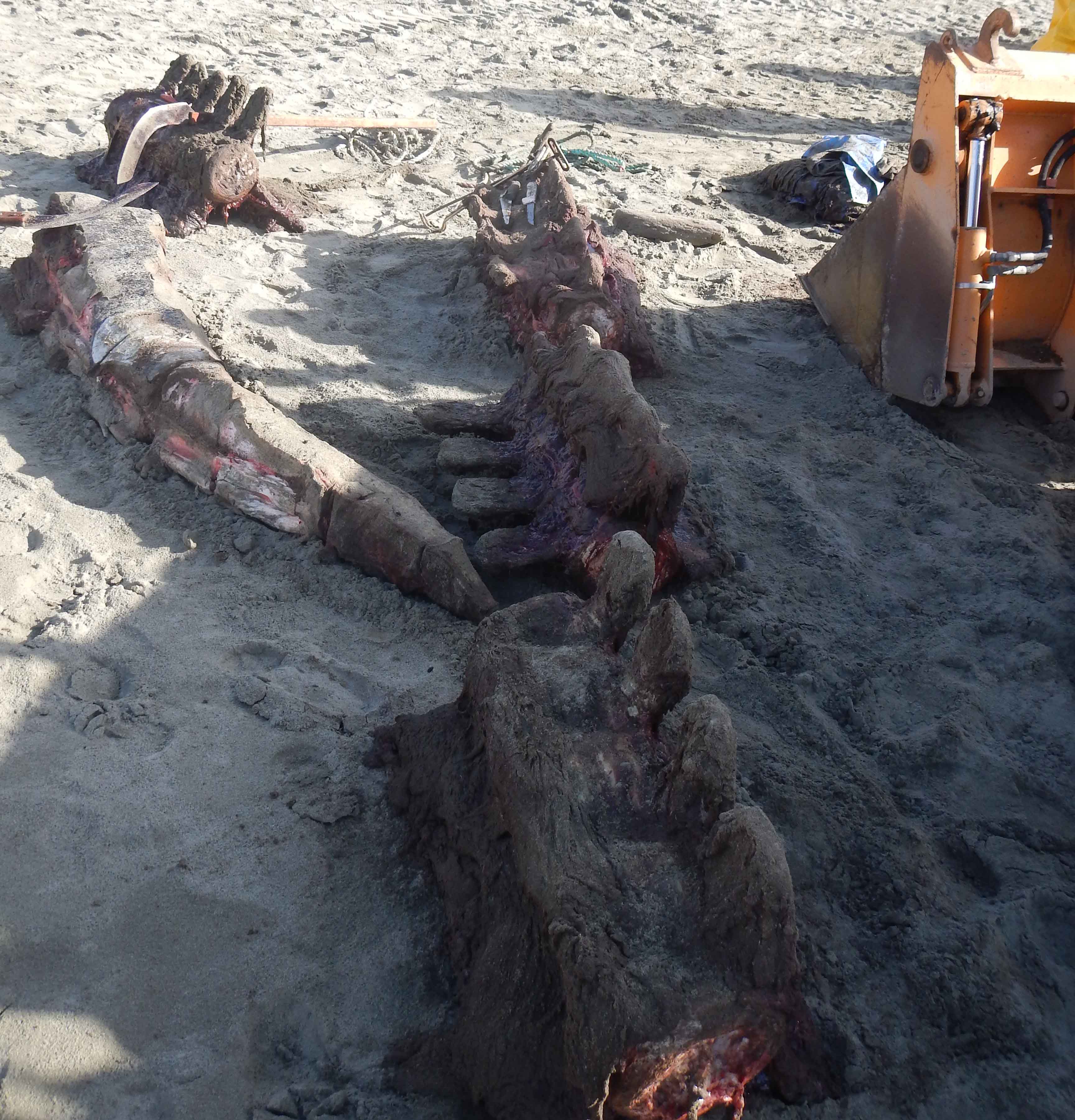 By the end of the day we had the animal into moveable pieces and loaded into a pickup truck. The sand made it easier to grip the slippery remains. The bones now are buried and will decay in a mixture of sand and soil for about a year. Mike DeRoos of Cetacea, suggested we let this skeleton sit for a year and let it decay slower and at a cooler temperature, just in case the bones were not solidly ossified. If the bones are heated too much during the decay process, they will become brittle.
By the end of the day we had the animal into moveable pieces and loaded into a pickup truck. The sand made it easier to grip the slippery remains. The bones now are buried and will decay in a mixture of sand and soil for about a year. Mike DeRoos of Cetacea, suggested we let this skeleton sit for a year and let it decay slower and at a cooler temperature, just in case the bones were not solidly ossified. If the bones are heated too much during the decay process, they will become brittle.
I am hoping to have this whale on display at the Royal BC Museum in the future – it will depend on how nicely the bones turn out at the end of the process. As far as research is concerned, it will be fine as a representative of the species, but for display, we want it to be perfect. Stay tuned.
Once we were done, our raingear was power-washed. Then I ate a few cookies and had some coffee, and Ken and I drove to Parksville. My Mom had dinner ready for us (you guessed it, stew). Then after dinner I drove back to Victoria – arriving home at 11:30 PM. That was a long day, but at least the Crosstrek I rented was fun to drive, and that kept me awake.
Someone on the team mentioned that volunteers commonly help with one whale – then never return. So I’ll end this with a quote from a popular movie personality.


